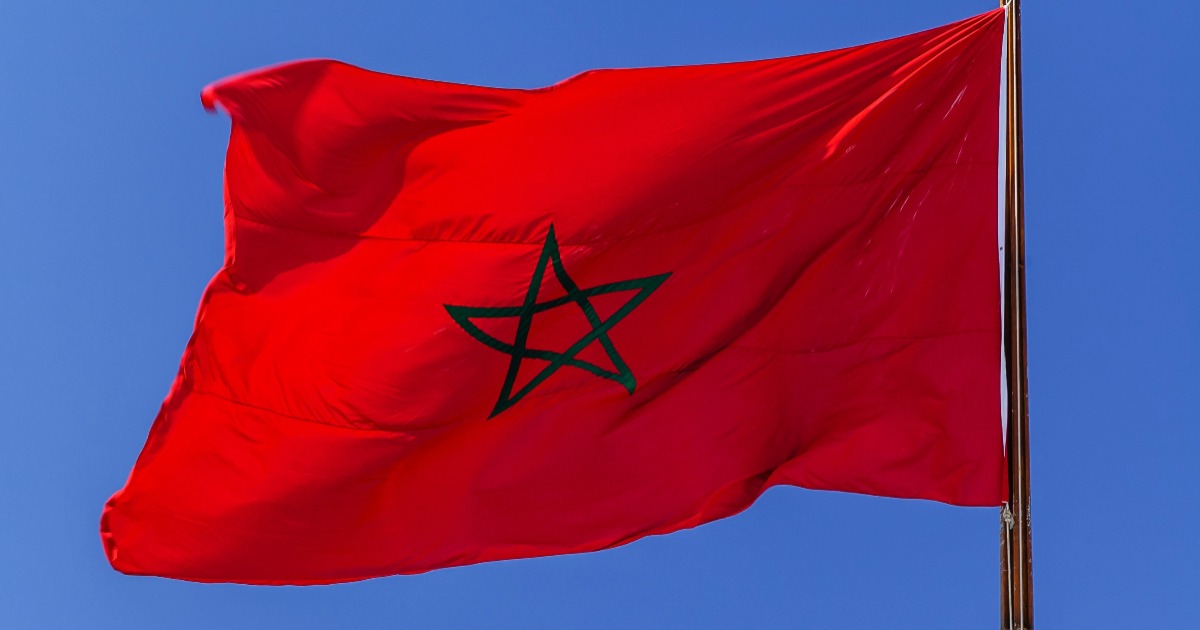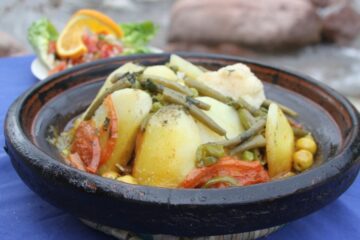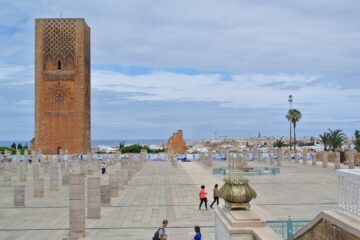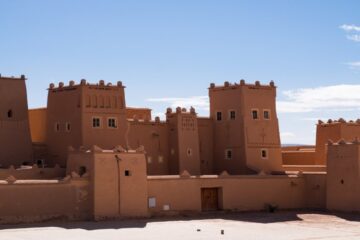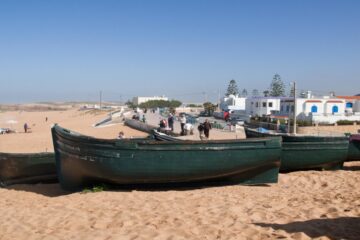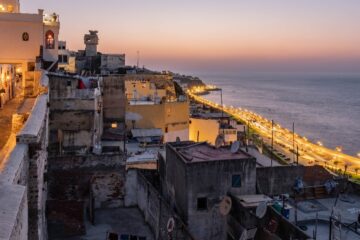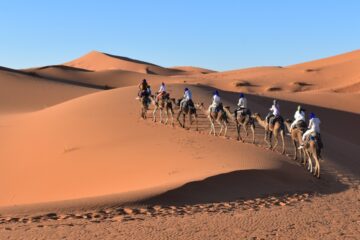The Moroccan flag is a sign of identity and pride for Moroccans. It is made up of two hues, red and green, which signify war courage and power. The flag has a rich history dating back to the 19th century, when Morocco gained independence. This article will look at the Moroccan flag’s significance, colors, and history, as well as other flags used in Morocco today.
The red hue of the Moroccan national flag denotes battle hardiness, courage, strength, and valour, while the green color represents hope, joy, optimism, and love for all people regardless of background or beliefs. The five-pointed star in the center represents solidarity among all Moroccans, regardless of cultural or religious differences. It also acts as a reminder to be faithful to Allah (God) during life’s struggles and tribulations.
Meaning of the Moroccan flag
The Moroccan flag represents the country’s link to Islamic culture, as seen by the green interlaced pentagram, which is said to symbolize Solomon’s seal. The five points of the flag’s star each represent a symbolic value related to Islam’s five pillars: certificate or witness, prayer, almsgiving, fasting, and pilgrimage. This significant national emblem represents these elements, which are essential elements in the lives of all Muslims.
1: Certificate or testimony
Two witnesses are required to proclaim a Muslim according to the phrase “la Ilaha illa Allah, Muhammad Rasul Allah.” For many Moroccans, this manifestation of religious conviction represents togetherness. This certificate or witness promotes women’s rights, freedom of expression, political representation, historical preservation, and equal access to education for all Moroccans.
- Women’s Rights: ensuring that Moroccan women are given equal opportunity in terms of legal rights and protections from discrimination.
- Freedom of speech: enabling individuals to express their opinions without fear of persecution or punishment
- Political representation: establishing an inclusive government in which all voices can be heard and represented fairly.
- Heritage Preservation: preserving cultural values through language, religion, customs and traditions in order to ensure that future generations know where they come from and what their ancestors believed in.
- Education Access: providing free access to quality education for all Moroccans, regardless of gender, socio-economic status, or ethnicity.
This certification is important because it allows citizens to feel connected to one another despite differences in culture or beliefs; creating a strong sense of community among those who share this faith, as well as celebrating diversity within Morocco itself, is just one way the country has been able to make strides toward progress while still preserving its rich history and culture.
2. Prayer
Prayer is an essential component of the Islamic religion, providing a direct route of connection between believers and Allah without the need for middlemen. A community-selected leader who is knowledgeable about the Qur’an leads the five daily prayers, which commemorate Solomon’s pledge of obedience to God. Although they may be conducted anywhere, all prayers must face Mecca. Interfaith conversation has shown that frequent prayer may lead to spiritual development as well as greater knowledge of various rites and practices. Individuals obtain spiritual insights while also expressing their yearning for emancipation from repressive regimes via prayer. Prayers may take many different forms depending on history and belief systems; nonetheless, their goal remains constant: to initiate connection with God via holy words or deeds.
3. Alms
Giving alms is an essential element of Islamic doctrine because it reminds believers of their commitment to aid those in need while also expressing appreciation to Allah. In Morocco, a five-pointed star represents this dedication on the flag. This star represents the value of philanthropy and giving one’s fortune to help others. Every believer is obligated to contribute 2.5 percent of their annual income to care for the poorest among us. This not only shows respect for those who are less wealthy, but it also enhances society’s unity and encourages people to give to others out of love rather than duty. When we share our resources with one another via acts of kindness and philanthropy, we develop stronger communities and highlight how intertwined mankind actually is.
4: Fasting
Fasting during Ramadan is an essential component of Islamic tradition that reminds Muslims of their commitment to aid those in need. This fasting is a one-of-a-kind act of self-purification that promotes empathy for those who are hungry while also assisting in the development of self-control. Muslims are not authorized to eat, drink, or participate in sexual behavior during this fast. Ramadan fasting practices give spiritual and physical advantages, as well as food limitations that must be maintained throughout the month. These practices are said to increase one’s relationship to God through deeper prayer and meditation. Furthermore, if done properly, they may help in weight reduction and enhance general physical fitness. Breaking the fast at night enables families to gather together and enjoy the conclusion of another successful Ramadan day.
5. Pilgrimage
A significant component of every Muslim’s spiritual practice is pilgrimage, which comes after fasting. The pilgrimage to Mecca is a religious trip that every Muslim must undertake at least once in their lifetime. This holy voyage has numerous separate components, including circumambulation of the Kaaba, visits to other sacred places and ritual baths, and the donning of certain sacred clothes. All of these features lead to the most significant location, the Kaaba in Mecca.
During this journey, the Irham is worn to represent solidarity among believers by removing social class boundaries. It is made up of two pieces of white cloth that wrap the body from the waist down and is often worn with a cap on top of the head. Circumambulating the Kaaba seven times while wearing this robe is one of several rituals performed throughout this voyage, which also involves visits to holy places such as Medina and Jerusalem, as well as other pilgrimage sites based on personal preferences.
Also read: The 9 Morocco Unesco World Heritage Sites
The Moroccan national flag’s history
Disagreements about the Moroccan flag’s creation date, creator, and initial meaning complicate its history. The Idrisid dynasty raised the first Moroccan flag in 788 to signify their realm. Though it began as a white field, it has developed into a red backdrop with a green five-pointed star in the middle. The introduction of this star by royal decree in 1915 has since shaped Morocco’s distinctive national identity.
For many Moroccans, the colors and star on the Moroccan flag symbolize liberation from tyranny and optimism for a better future. The color red denotes hardiness, bravery, strength, and valor, whereas the color green represents love, joy, wisdom, and serenity. As a result, these colors have evolved to signify much more than simply a symbol of nationhood; they are also symbolic representations of cultural values that have been handed down through centuries.
Other flags of Morocco
The Moroccan national flag has a long and colorful history. It has grown through time to become a symbol of Morocco’s independence and identity, although it is not the only flag flown in the nation. Other variations of the Moroccan flag include civil and naval emblems, both of which contain a yellow crown and star. These symbols are important for a variety of reasons, since they symbolize both Morocco’s cultural legacy and its political symbolism.
The civilian emblem is identical to the official flag but has a yellow crown and star in the top left corner. This design embodies Moroccans’ strong sense of national identity while also showing their culture’s aspiration for advancement and prosperity. The naval flag has two stars on each steed to highlight this connotation, providing individuals who serve in Morocco’s navy symbolic value. This serves as a reminder that patriotism should be prioritized while serving one’s country, regardless of profession or job title.
You might also like Hidden Gems: Off-The-Beaten-Path Destinations In Morocco
Some flags also used in Morocco are
Other flags, in addition to the national flag, represent various elements of Moroccan culture and symbolism. One such flag, which is white in hue, is utilized at ceremonies. A crescent moon and white stars are present in each corner of the design, which centers on a green five-pointed star. This flag is religiously significant since it carries the words “There is no god but God, and Mohammed is his prophet” on it. Other flags are used to represent government offices or power, such as the Moroccan Royal Guard, which uses a green flag with a yellow star in the middle and two white stars at the corners. These flag varieties exhibit Morocco’s cultural history while also functioning as ceremonial flags or as emblems for religious or governmental bodies.
FAQ
The Moroccan flag’s red and green hues represent national pride, religious symbolism, and the royal crest. The green star represents a longing for independence and provides a hopeful aspect to the flag. These hues are all associated with Morocco’s rich history and elicit sentiments of pride and solidarity among its people.
The proportions of the Moroccan flag are 2:3. The red field contains a green pentagram star or five-pointed star, the five points of which represent the five pillars of Islam. The national anthem is written on the flag, and it is flown in accordance with government symbolic tradition and etiquette.
In popular culture, the Moroccan flag is used to promote soccer teams, signify cultural identity, reference historical events, use brand imagery, and bless religious rituals. Its colors and design generate a strong sensation of freedom among audiences all around the globe.
The design of the Moroccan flag has undergone a number of changes over time, with royal symbolism, cultural interpretations, and traditional motifs being employed in its redesign. Its current iteration incorporates religious symbolism, reflecting the nation’s historical context. The design reflects a desire for freedom and captures the spirit of Morocco’s people in an engaging manner.
Regional flags often incorporate graphic features and cultural allusions that show national pride and regional influence, in addition to the Moroccan flag. These symbolic flags serve to bring people together by instilling a feeling of identification, pride, and independence.
Conclusion
For many Moroccans, the Moroccan national flag is a source of pride, signifying the country’s independence and long-standing cultural legacy. The flag’s colors of red, green, and white are thought to reflect the political principles of modernism, tradition, and purity, in that order. In addition to its main colors, the five-pointed star at its center has come to be recognized as a symbol of unification among Morocco’s many faiths and nationalities. Since its inception in 1915, all of these aspects have contributed to the Moroccan flag being a significant component of the country’s identity. It still exists as a reminder that, regardless of their views or origins, all residents are united under one flag.

